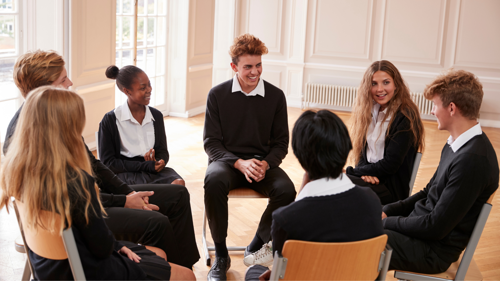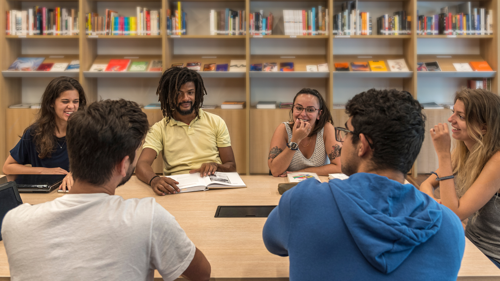Collaborative learning strategies are the tactics fantastic educators like you use to help students learn collaboratively, in pairs and groups, to facilitate their understanding of the material in a new way and prepare for the future.
When students learn collaboratively, they are responsible for solving a problem, finishing a task, or creating a project with a group. In addition, they are responsible for not only making sure the entire group succeeds but also managing their own role within the group to facilitate that success.
Rather than having a predefined role, students create and shift their individual roles within the group to ensure overall success.
What Is Collaborative Learning?
Collaborative learning is an educational approach where students work together in groups to explore a significant question or create a meaningful project. Rather than being passive recipients of knowledge, students actively engage with the content and each other. The emphasis is on cooperation and shared responsibility, allowing each student to contribute uniquely to the group’s success.

Why Is Collaborative Learning Important in the Classroom?
Collaborative learning plays a critical role in helping students develop not only academic knowledge but also interpersonal skills. It fosters a learning environment that reflects the collaborative nature of today’s workplaces. By engaging in group activities, students learn how to communicate effectively, think critically, and resolve conflicts—skills essential for lifelong success.
What are the benefits of collaborative learning?
Since companies are also using collaborative learning to help build employee skills and relationships, students who learn collaboratively in school will be better prepared for similar work in the future.
There are plenty of benefits of collaborative learning and below are five of those benefits and some tips to get started.
Leadership and Self-Management Skills
Since students engaged in collaborative learning have to manage their goals as a group and also their individual roles within the group to reach that goal, students naturally learn to not only lead but also self-manage.
Inevitably, students will have to take on leadership roles within the group in order to succeed collaboratively but will also need to adjust their individual roles as the project progresses. They will discover their strengths and weaknesses individually and learn to manage those traits for effective group work.
These skills will be crucial to future success in any career, as students will need to know how to self-manage no matter what their future holds.
Wider Range of Knowledge and Skill Acquisition
Since students do not have set roles during collaborative learning projects, they will end up learning more knowledge and skills than they would if they had a defined part in the project.
Students will have to take on various roles throughout collaborative learning situations and will thus learn more about what types of roles they are naturally great at taking on, along with roles upon which they could improve.
Not one student will be the leader, the scribe, the presenter, etc. So, all students will be able to improve those skills and have to know information for each element of the project to succeed.
Improved Student Relationships
Collaborative learning also improves student relationships and teaches students how to manage different perspectives and personality types.
Since each member of the group is essential to the outcome, students will learn to embrace each other’s strengths and learn how to work effectively together.
They will also bond over their collaborative projects and learn to find value in every kind of student. Every student will need to listen to each other’s ideas and will see that a diverse set of ideas adds more creativity to a project.
Better Concept Retention
When using collaborative learning to help students understand important concepts, educators can help students retain the information for a much longer period of time.
Students will have to actively engage their understanding of a concept in order to succeed in their collaborative learning project, so they will be able to apply their learning to a real-world context and see how the concepts they are learning relate to their project.
This will better solidify the information in their minds for years to come.
Promotes Active Listening and Critical Thinking
While working collaboratively in groups, students will have to listen actively and think critically in order to solve problems and reach their goals.
They will not be able to simply get through the project by finishing their part in it but will need to listen to others to ensure all parts of the project are working effectively. They will also have to use their critical thinking skills to solve any issues that arise and find alternative solutions when necessary.

Real-World Applications of Collaborative Learning
The benefits of collaborative learning extend far beyond the classroom. In many modern workplaces, professionals are expected to collaborate across teams, manage complex group dynamics, and contribute to shared goals.
Students who regularly engage in collaborative learning are better prepared for these real-world expectations. They gain experience working through disagreements, negotiating solutions, and delivering quality results as part of a team.
Collaborative Learning Strategies for Teachers
If you’re interested in utilizing collaborative learning in your classroom, all you need to do is convert projects you might assign to students individually into group projects instead.
Rather than giving out a worksheet to help students learn a concept, for example, break students into groups and give them a task to achieve together. They could complete a worksheet together, have a group discussion and come up with a list of their insights, or even create a presentation on a topic. The key is, you won’t assign roles and will let students manage their roles on their own.
You can also create long-term projects that students will need to complete in a group, which will also challenge students to manage their time to complete a longer assignment by the deadline you give them.
Now, here are some basic tips to keep in mind as you create collaborative learning opportunities for your students:
Establish group goals and values
When you start asking students to work in groups, you’ll want to make each group’s goals clear and establish expectations for how groups will work together and behave. This will ensure individuals within the group are on the same page.
For example, tell students that they should not expect to take on a leadership role the whole time or rely on a natural leader to take on all the work or responsibility. Explain that the goal is to truly work as a group, and sometimes students will be leading, while other times they will need to follow.
Group students strategically
Diverse groups often work together better and give students a chance to hear ideas from people who have different backgrounds and tendencies than they do.
Consider grouping students with a balance of gender, for example.
In addition, make sure you’re not grouping together all students who tend to lead or all students who tend to remain quiet during class. You’ll want a variety of personality types to ensure a synergistic group dynamic.
At the same time, you can put two natural leaders in a group to help them learn how to share responsibility.
Monitor group dynamics
As students work in their groups, monitor the group dynamics to make sure students are not taking over the project or not allowing each student in the group to take on a role.
You can also model effective ways to discuss as a group and give students examples of how they can actively listen to each other to come up with a solution.
Encourage diversity of thought
Sometimes group dynamics can work too well so that group members just want to agree with each other to keep the synergistic atmosphere. So, encourage students to disagree with each other if they have a different opinion.
Explain that diversity of thought helps to create stronger results. However, make sure students understand that they should not disagree just for the sake of disagreement.
Debrief after the project or assignment
To help students retain what they learned and process the experience, debrief with students after the project or assignment.
This will allow students to think through what they learned and the skills they gained from working as a group.
You can do this out loud, have students fill out feedback forms about their experience, or both.

Challenges of Collaborative Learning and How to Overcome Them
As effective as collaborative learning can be, it’s not without its challenges. Some students may dominate the conversation, while others might be hesitant to contribute. Conflict can arise over different ideas or working styles. The key is to set expectations early, provide guidance throughout the process, and model productive group behavior. Monitoring and scaffolding are important steps to ensure that all students benefit from the experience.
Collaborative Learning Examples for the Classroom:
Looking for ideas to get started? Here are a few examples of collaborative learning activities:
-
Group debates on a current issue
-
Joint research projects with shared presentations
-
Peer review workshops
-
Brainstorming sessions followed by group writing
-
Role-playing scenarios that reflect real-world problems
These activities give students a variety of ways to collaborate while developing both academic and interpersonal skills.
The Long-Term Value of Collaborative Learning
However, you choose to engage students in collaborative learning, enjoy the process!
You will find that your students learn and grow exponentially from collaborative learning, which is always a joy to witness as an educator. More importantly, you’ll be setting them up for long-term success in school, their careers, and life in general.
